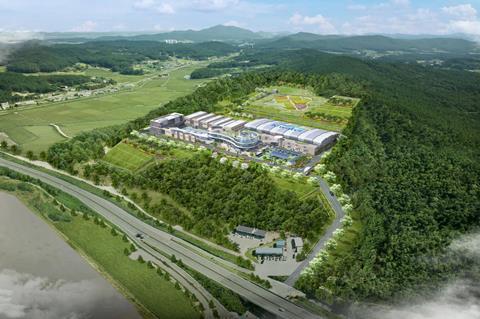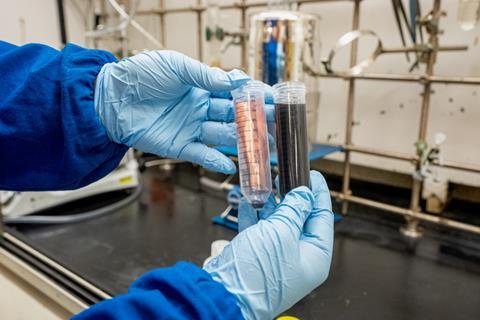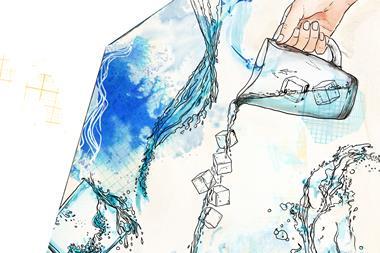As the chemical industry becomes more sustainable, it will require more water. Angeli Mehta looks at whether there is enough to go round
There can be no net zero without water. Water sits behind all the sectors needed for the transition: energy, chemicals and mining critical minerals. All face water risks. Rightly the focus has been on carbon, but as we ‘rush to the transition, there are blind spots. We’re overlooking water,’ says Patricia Calderon, associate director for water security at CDP, a charity that runs a global disclosure system to help companies and states to manage their environmental impacts.
Companies in the chemicals sector making everything from fertilisers to specialty chemicals are scoring ‘critical’ on CDP’s index. While almost 5000 companies are disclosing to CDP, just 180 critical to the transition are doing so. Take biofuels: less than a third of the biofuels companies that have been asked to disclose did so. Of the four who did, two identified potential risks to both operations and their value chain. Again, few companies in the mining, oil and gas sectors disclose their water data, but some have identified threats to production.
The more modern the society, the more water consumption
Today’s energy sector consumes vast amounts of water. Avner Vengosh’s research group at Duke University in North Carolina, US, has worked on the energy–water nexus for some years, exploring a vicious cycle of growing demand. ‘The more modern the society, the more water consumption and withdrawal. And then you need more energy, and more water [and] then you pollute more water.’ Treating wastewater and moving treated water again requires more energy.
He calculates that the fossil energy and power sectors withdraw almost seven times as much water as they consume. How the water that’s returned is dealt with will vary according to national regulations, but the fossil fuel sector along with metals and mining, chemicals and pharmaceuticals have the most severe impact on water quality.
According to the International Energy Agency 54.1 billion cubic metres of water were used to produce energy and generate power in 2021. That could rise to 61.2 billion by 2030, unless we decarbonise in line with a net zero strategy. In that case, water consumption would still grow, but by half as much thanks to replacing coal with wind and solar, and to greater energy efficiency.
In the IEA’s scenario, bioenergy will account for more than half of total water consumption in the energy sector. Much of that will be used to grow crops for energy and to deliver negative emissions through bioenergy carbon capture and storage. How much will depend on the source, with the most water-efficient biofuels being those produced from crop residues. The water footprint of bioethanol, for example, is eight times smaller if it’s produced from sugar beet residue compared to sugar beet crop.
Water for energy
Hydrogen is often touted as a key fuel for the transition – both to produce energy and to store it. Every kilogram of green hydrogen produced via electrolysis consumes at least 9 litres of water. But water purification and process cooling can at least double that. Producing hydrogen from fossil fuels with carbon capture and storage is far more water intensive, however, consuming between 30–40 litres per kg. The IEA expects that by 2030, 1.9 billion m3 of water will be needed to produce hydrogen for energy. Most of that demand is initially expected to come from existing industries such as refining, and ammonia and methanol production, in turn lowering their water footprint.
Where hydrogen can be produced is another matter.
The Canadian province of Alberta has placed a big bet on hydrogen, but climate change is impacting current and projected water supplies. An analysis of planned hydrogen projects shows that in some watersheds these could consume up to half the water available, while in others the water stress is so high that no new water licenses can be granted.

Another potential use of hydrogen is to make transportation fuels. Over 20 projects have been announced worldwide to produce so-called e-fuels, such as e-methanol and e-gasoline, from captured carbon dioxide and hydrogen. The Haru Oni demonstration plant in Chile, built by a consortium involving Siemens Energy, to provide fuels for carmaker Porsche, is sited in a windy – but arid – region. Producing 130,000 litres of e-fuel consumes 10 times as much water, but a larger planned facility will recycle water during the production process. In theory this should mean that each litre of e-methanol will consume around 1.5 litres of water, while 3–4 litres of water will be needed for every litre of e-gasoline produced. The new plant will use desalinated water, so will not draw on existing water supplies.
Depending on where hydrogen is consumed, the water could be recovered. For example, Swedish steel maker SSAB is using hydrogen to make clean steel and recovering the combustion water to recycle it back into the production process.
Robin Hamilton, a chemist at the University of Alberta, thinks hydrogen fuel cells could themselves provide a solution for clean water supplies in disaster zones or where communities are off-grid.
He was trying to develop a catalyst to upcycle waste carbon when he discovered it could generate hydrogen from water. The catalyst material , which is abundantly available, turns out to prefer wastewater, including from mine tailing ponds. The reaction can take place at room temperature, if an oxygen scavenger is present to provide the chemical energy needed. But it must be replenished. Potentially the scavenger could be used to ‘jump start’ the reaction if no other energy source is available.
Running the hydrogen through a fuel cell produces clean water, although Hamilton cautions ‘due diligence is required to make sure any contaminants from the water source don’t bleed through with the gas stream’.
Now he and his colleagues at start-up Dark Matter Materials are working on tuning the catalyst to different water sources, including agricultural wastewater, that could in turn cut hydrogen’s clean water footprint.
Squeezing more from water
Increasingly, the water needs of the petroleum industry and the nascent hydrogen and synthetic fuels industries are going to have to be provided from desalination plants. And here there might be opportunities to make more than just water.
One start-up, New Zealand- and US-based Capture6, is developing a series of pilot plants that will use the brine from desalination to make chemicals to capture carbon and extract more water. In January it signed a memorandum of understanding to work with South Korean water Utility K-water, which is constructing a 100,000m3 a day desalination plant that will supply water to a nearby industrial complex making fuels and plastics.

Capture6 will use the desalination brine to make a sodium hydroxide solvent to capture carbon dioxide from the air flowing through (for example) cooling towers. But its process will also extract more water from the brine. Chief executive Ethan Cohen-Cole expects that will amount to over 37m3 for every tonne of carbon captured. If the pilot is successful, they intend to scale initially to capture 500,000 tonnes of carbon dioxide from both air and point sources at the complex, which could mean it’s providing half as much water again as the desalination plant.
While sodium hydroxide is highly efficient at bonding with carbon dioxide, a lot of energy is required to release the captured gas. But Capture6 will store it as carbonates, which can be used in nearby industrial processes.
Cohen-Cole says the company is getting inquiries from ammonia producers as well as companies in the power and pharmaceutical sectors. ‘The disposal cost in many industries is exceptionally high, and regulation is increasing. Because the capture system itself can generate revenue from selling carbon credits and water [we’re] actually enhancing the economics of the entire integrated system.’
Modelling of the water requirement of stand-alone DAC systems at net zero scales – up to 30 gigatonnes – suggests it could be less than a third of the volume required by bioenergy carbon capture and storage systems. The latter need water both to grow crops and in the capture process. In Climeworks’ DAC system, steam is required for the desorption of carbon dioxide from the capture material. Some water is lost via evaporation, but the rest recycled. At its existing 4000 tonne plant and a new 36,000 tonne plant (now in commissioning), water is used to transfer the captured carbon dioxide to its storage partner Carbfix. Carbfix injects dissolved carbon dioxide into basaltic rock, and once mineralised (within two years) the water returns to the earth’s system.
Minerals for a new energy economy
The Energy Transition Commission estimates there are enough minerals on earth to meet the demands of the transition, but a huge ramp up in mining and recycling is needed and thus also in its water demand. By 2050, however, mining for transition metals is likely to consume only half as much water as coal mining does today.
While critical minerals mining accounts for a fraction of total global water use, it can have an outsized impact at a local level – not just on consumption but on water quality. One recent analysis of global information system (GIS) data assessed the impact of metal mining and refining on regional water availability and water stress. For example, almost 70% of global platinum production and over 35% of palladium production is concentrated in South Africa’s Limpopo River basin, a region of high water stress. Cobalt, most often discussed in terms of human rights abuses, is mined in the Congo River basin in the Democratic Republic of the Congo which provides around 60% of global production; while in Chile’s northern Loa basin, mining for copper and molybdenum is the main driver of water stress.
Indeed, there may be places where the risks and impacts of mining are just too great, says Aimee Boulanger, executive director of the Initiative for Responsible Mining Assurance (IRMA). ‘But we also face the inconvenient truth that you can’t move where the minerals are [found].’
The original impetus for IRMA came from the jewellery sector but it’s electric vehicle manufacturers who are now moving the needle. ‘The volume of what they buy really signalled to the mining sector an expectation for social and environmental improvement,’ she adds. However, the number of mining sites being audited is still just a fraction of those worldwide.
One of the most expensive challenges for the industry is managing water to keep it clean.
Its uncontrolled movement is what causes the real damage. For example, ore containing copper and gold is often rich in sulfides which, when exposed to water and air, form sulfuric acid. A hazard itself, it can also dissolve out other dangerous chemicals like arsenic that accumulate in tailing ponds and enter the ecosystem. So called acid mine drainage can leave a legacy lasting centuries, damaging waterways and biodiversity.

In the labs of Tersa Earth, based in Vancouver, Canada, they’re using microbes to clean up and to extract the valuable metals from acid mine drainage – estimated to be worth some $20 billion in north America alone. Treating ARD is traditionally done with lime, which is carbon intensive to produce and leaves a sludge that has to be buried in landfill. In a first step, microbes that generate electric currents over highly tuned membranes are used to recover valuable metals in their elemental form from the acidic waters. The next step also uses microbes, this time to neutralise the acid by precipitating out carbonates of metals such as magnesium, lead and arsenic. The base gets recycled to further neutralise incoming acid. The carbonates can be completely recovered before the water is released, explains Navya Mopati, a bioprocess engineer at Tersa. In theory the water could be recycled for re-use at the site. The company is developing a demonstration unit and talking to provincial government about remediation at closed mine sites, where the public usually has to pick up the bill for clean-up.
Unlike today’s fossil fuel industry, many of the resources that are mined for batteries and fuel cells could be recycled, cutting mining requirements in years to come. While recycling will play a minimal role this decade, researchers are working on the challenge of metals recovery. Today’s valuable battery materials are bound together in a ‘black mass’ that’s energy intensive and toxic to separate. Water soluble binders could change the picture. Hong Kong based GRST won the Earthshot prize in 2023 for its water-soluble batteries, while commercial testing of a water-soluble binder developed by scientists at Lawrence Berkeley National Laboratory in the US are underway. Their Quick Release Binder consists of two commercially available polymers that are easily broken apart in alkaline water containing sodium hydroxide. The electrode materials released can be filtered out of the water and dried and the polymers can be reused, according to project lead Gao Liu. ‘In our process we just break down the binders, so the water stream is much cleaner [than conventional battery recycling]. We know what’s in it, so we can manage it better at lower cost.’ He’s now working with battery materials companies to assess the requirements for different chemistries.
Doing chemistry in water
In the chemicals sector water is mainly used for cooling and cleaning, and that’s where companies have focused attention to reduce their consumption. But there’s little oversight of the water footprint of the supply chain – for example solvents and key metal catalysts.
Doing chemistry in – or on – water could help change the picture. European specialty chemicals producer, Evonik, is developing chemistry in water, or micellar catalysis, for the manufacture of active pharmaceutical ingredients. The technology has been pioneered by academics in the US. A reaction that would otherwise have taken place in a solvent goes on in tiny surfactant capsules or micelles that may range from 10–200μm, suspended in water.
Michael Nonnenmacher, who leads business development in Evonik’s healthcare business line, explains that the surfactant micelles are amphiphilic molecules with a hydrophilic head and a lipophilic tail. The tail helps bring organic substrates (which don’t dissolve in water) into the micelle.
Due to higher concentrations in the micelles, you can often use lower catalyst loadings
It works like a nanoreactor, Nonnenmacher explains, because ‘it brings those substrates close together, and due to this proximity and higher concentration [of substrates], typically the reaction rate is enhanced. Once the product is formed in the equilibrium, it can leave the micelle and then either stays in solution or ideally, cleanly drops out of solution and can be isolated.’
There are potentially big advantages in terms of sustainability, says his colleague Stefan Randl, head of drug substance. They have demonstrated several reactions that take place at lower temperatures. In many cases, there are enhanced selectivities and higher yields.
‘Say you get 90% instead of 85%, which basically means there are less organic compounds in the waste. Also, due to higher concentrations in the micelles, you can often use lower catalyst loadings, let’s say [instead of] 1%, you use 0.2%. So there’s also less of the catalyst in there.’
Those benefits of higher yield and lower catalyst loading are likely to mean lower impurities in the water – and the product – at the end of the process.
In an ideal system, the water and micelles could be re-used for a few cycles before impurities build up. The current standard surfactant has to be destroyed before the water can be sent to a conventional treatment plant. So another key focus for Evonik is to explore the development of second and third generation surfactants, which are biodegradable.
Although it’s in the pilot phase, Randl is hopeful that the micellar chemistry won’t necessarily require more water than when a reaction is run in an organic solvent. That’s because both workups and the manufacture of conventional solvents also require water. However, data on exactly how much water is used to make solvents is difficult to get hold of.
Swiss pharma company Novartis has also been working on surfactant technology for some years. It has reporteda reduction in both solvent and water use, and significant cost savings. More recently, it has shown that the wastewater from its target processes can be safely sent to conventional wastewater treatment plants.
There is every prospect that the chemicals sector can become more sustainable when it comes to water. But such is the parlous state of the world’s water reserves, it will need to seize on every advance and efficiency to make that a reality.
Angeli Mehta is a science writer in Edinburgh, UK


















No comments yet